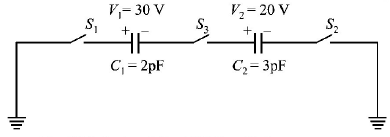Question
A parallel plate capacitor of area $$'A'$$ plate separation $$'d'$$ is filled with two dielectrics as shown. What is the capacitance of the arrangement ?
A parallel plate capacitor of area $$'A'$$ plate separation $$'d'$$ is filled with two dielectrics as shown. What is the capacitance of the arrangement ?

A.
$$\frac{{3K{\varepsilon _0}A}}{{4d}}$$
B.
$$\frac{{4K{\varepsilon _0}A}}{{3d}}$$
C.
$$\frac{{\left( {K + 1} \right){\varepsilon _0}A}}{{2d}}$$
D.
$$\frac{{K\left( {K + 3} \right){\varepsilon _0}A}}{{2\left( {K + 1} \right)d}}$$
Answer :
$$\frac{{K\left( {K + 3} \right){\varepsilon _0}A}}{{2\left( {K + 1} \right)d}}$$
Solution :
$$\eqalign{ & {c_1} = \frac{{\left( {\frac{A}{2}} \right){\varepsilon _0}}}{{\frac{d}{2}}} = \frac{{A{\varepsilon _0}}}{d}, \cr & {c_2} = K\frac{{A{\varepsilon _0}}}{d},{c_3} = K\frac{{A{\varepsilon _0}}}{{2d}} \cr} $$

$$\therefore {c_{{\text{eq}}{\text{.}}}} = \frac{{{c_1} \times {c_2}}}{{{c_1} + {c_2}}} + {c_3} = \frac{{\left( {3 + K} \right)KA{\varepsilon _0}}}{{2d\left( {K + 1} \right)}}$$
($$\because {C_1}$$ and $${C_2}$$ are in series and resultant of these two in parallel with $${C_3}$$ )
$$\eqalign{ & {c_1} = \frac{{\left( {\frac{A}{2}} \right){\varepsilon _0}}}{{\frac{d}{2}}} = \frac{{A{\varepsilon _0}}}{d}, \cr & {c_2} = K\frac{{A{\varepsilon _0}}}{d},{c_3} = K\frac{{A{\varepsilon _0}}}{{2d}} \cr} $$

$$\therefore {c_{{\text{eq}}{\text{.}}}} = \frac{{{c_1} \times {c_2}}}{{{c_1} + {c_2}}} + {c_3} = \frac{{\left( {3 + K} \right)KA{\varepsilon _0}}}{{2d\left( {K + 1} \right)}}$$
($$\because {C_1}$$ and $${C_2}$$ are in series and resultant of these two in parallel with $${C_3}$$ )

